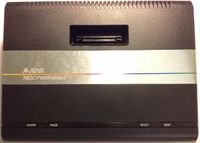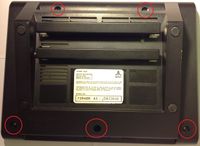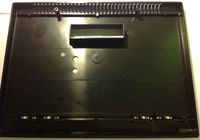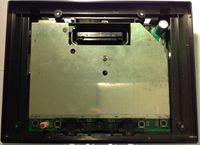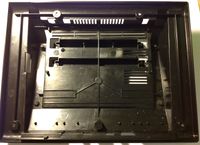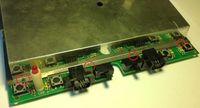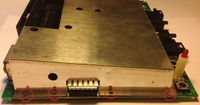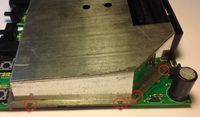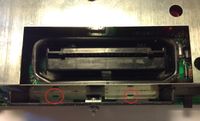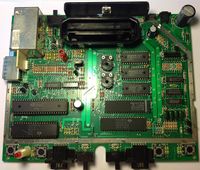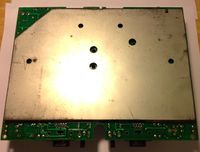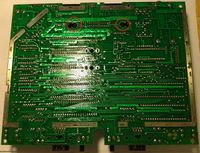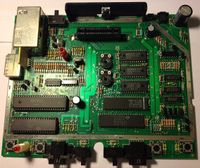Atari 7800 Teardown
| This is a guide for completely disassembling an Atari 7800. The process is mostly straight-forward, but removing the RF shield can be frustrating. Click on any of the images for a larger version.
You will need the following tools:
|
Contents
Step 1 - Open the case[edit]
| Flip the console over and remove the 5 screws on the bottom, which are circled in the picture. Turn it back over and lift the top off. The top should come off effortlessly. | |
| Here is the underside of the top of the case. The buttons can be removed easily by pushing the small plastic tabs inward and down. |
Step 2 - Remove the motherboard from the case[edit]
| The motherboard is not physically attached to the case, so there are no screws to remove for this step. To take the motherboard out of the case, lift up the back end first so you can slide the controller ports out of the holes in the case. You may damage the controller ports if you attempt to lift the front end first. | |
| Here is the inside of the bottom half of the case. You can see the revision number for the 7800, which in this case is C024536. Note that this number is different from the revision numbers on the motherboard. |
Step 3 - Remove the RF shield[edit]
| Fully exposing the motherboard can be somewhat time consuming. The board is partially encased by an RF shield consisting of top and bottom halves that interlock using several metal tabs, which are bent to prevent the halves from detaching. There are 14 metal tabs, and you'll have to straighten each one to remove the shield. There are 4 tabs on each side except for the back near the cartridge slot where there are only 2 (see pictures). Save the 2 in the back for last. To straighten the metal tabs, you need to use a small pair of pliers. If a tab is bent down too far to get the pliers around it at first, use a small flat head screwdriver to pry the tab up and then use the pliers. First use the pliers to make the tabs stick up, an then use the pliers to clamp down on the tabs to make them as straight and flat as possible; just one slightly misshapen tab will prevent the RF shield from coming off. In the pictures, I've already straightened most of the tabs, so use that as a guide to see how the tabs need to be positioned. |
|
| The 2 tabs behind the cartridge slot require some special care. These are not exposed like the other 12 tabs because the heat sink on the voltage regulator gets in the way, making it difficult to reach them with pliers. If your pliers won't fit, you'll have to make do with the small flat head screwdriver. The RF shield and the heat sink can be bent some without damage, so you can carefully shove in a pair of pliers that's slightly too big. Once all the tabs are as straight as you can get them, try to lift off the top half of the RF shield. It will probably take a bit of force since it's difficult to make the tabs perfectly straight. If it just won't come off, figure out which tab is causing problems, straighten it again, and continue. It will come off eventually. |
|
| Here's what the board looks like with only the top half of the RF shield removed. | |
| Now flip the board over to remove the bottom half. The metal tabs are still sticking through the motherboard itself, so carefully pull the RF shield straight up and off the board. You may need to go back and restraighten any metal tabs that got bent when taking off the top half. Once the bottom half is off, you should take this opportunity to use your pliers to flatten the 2 tabs that sit behind the cartridge slot. |
Step 4 - Remove the plastic cartridge slot enclosure[edit]
| With the RF shield off, you can finally remove the final piece, which is the black plastic piece which surrounds the cartridge slot. It's easy to remove: first, remove the two screws holding the piece in place. These screws are smaller than those on the outer case, so you'll need a different screwdriver. Next, push the tabs inward and down through the holes, and the plastic piece should pop out easily. | |
| And there you have it! The motherboard is now fully exposed. |
Reassembly[edit]
To reassemble the Atari 7800, you just need to follow the steps outlined above in reverse. This is easier said than done since the RF shield is harder to get back on than to take off. Besides the RF shield, use the pictures above to make sure you orient the plastic cartridge slot enclosure correctly.
Putting the RF shield back on is as much of a chore as it is to take it off. First, with the bottom half of the RF shield detached, take your pliers and make each tab as straight as possible. Then very carefully attach the bottom half of the RF shield to the motherboard, taking special care not to bend the 2 tabs in the back, which will return to their unreachable void.
I have no great tips for putting the top half back on. Even with all the tabs perfectly straight, you'll find that the RF shield just doesn't quite fit. What you need to do is get the RF shield onto the tabs on one side of the board and then gently bend the remaining metal tabs one-by-one to force them into the remaining slots. You should start with the back side so you don't have to worry about the 2 hidden tabs. As you do this, you'll probably bend some of the tabs too far and have to start over. Just take your time, be gentle, and eventually you'll get it back on.
Once the RF shield is back on, you'll need to resecure it. If you ever plan on reopening your 7800, then do not bend all of the metal tabs back into place. Leave most of them straight, and only bend 3 or 4 easily accessible tabs to hold it together. After that, put the motherboard back in the case, making sure to put the front end in first to slide the controller ports into place. Close the case, screw everything back together, and you're done!
